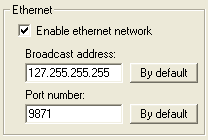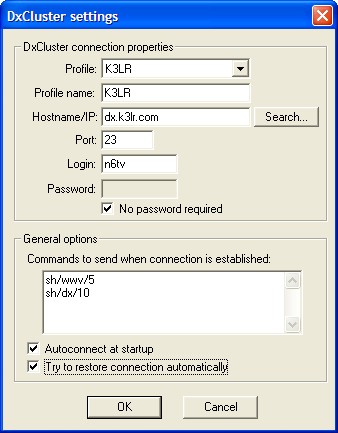DX Cluster/Telnet
Connecting to a telnet cluster is the work of an external application provided as part of the Win-Test package called 'wtDxTelnet'. This program maintains the connection to the cluster, NOT Win-Test itself! This is a commonly asked question on the support reflector, hence the emphasis!
Configuring wtDxTelnet (single-op environment)
The reasoning behind using a separate program for maintaining a telnet connection was to be able to have only one connection in a multi-op environment, rather than having to connect every time on each individual machine in the shack!
Configuration of wtDxTelnet is not a hard process, and like everything else configuration-based in Win-Test, needs only be done once. This section explains how to setup wtDxTelnet and Win-Test for use in a single-op environement - there are further instructions on what has to be done in a multi-op environment below.
Configuring Win-Test for wtDxTelnet
Firstly, open the configure interfaces dialog in Win-Test (Options | Configure Interfaces...). Tick the box labelled 'Enable ethernet network' and ensure it looks like the following:
Click OK and that is the only change of configuration you'll have to make to Win-Test itself.
Configuring wtDxTelnet
Now start wtDxTelnet (in Windows, Start|Programs|Win-Test|wtDxTelnet). From its menu choose 'Option|DxCluster properties'. The screen should look something like this:
A quick description of the various settings here:
Hostname/IPis the hostname (e.g. ab5k.net, gb7djk.dxcluster.org, etc) or the IP address of the DX cluster which you want to connect toPortis the port number which the DX cluster you wish to connect to runs on. For DX spider clusters (quite common nowadays), this is 7300 or 8000.Loginshould be your callsign (which you usually type at the Login: prompt)Passwordis a password (if required) to allow you to login to the cluster. Most do not require one, so tick the box beneath labelled 'No password required'Commands to send at connectioncan be used to send commands such as sh/dx/20 for the last 20 spotsAutoconnect at startupwhen ticked will connect to the cluster automatically when you start wtDxTelnetTry to restore connection automaticallywhen ticked will try to restore a connetion automatically if you are disconnected (for whatever reason)
Click OK and your changes will be saved permanently.
Next, from the same menu select the Options|Win-Test network properties and the screen should look like the following:
Note the matching broadcast address and port number as you specified earlier in Win-Test? Also, these may well be greyed out by default in which case be sure to untick the box labelled 'Disable communication with Win-Test' and then all will be well. Also note that wtDxTelnet must always be running in the background whilst connected to the cluster!
Testing the configuration
Now you have setup both Win-Test and wtDxTelnet, it is time to ensure you can connect to the cluster, login fine and see spots coming through in Win-Test. Ensure that wtDxTelnet is connected to the cluster (you can see that in the main wtDxTelnet window) and if not, use the DxCluster|Connect menu option.
In Win-Test, open the DX cluster monitor window by going to the Windows|Dx-Cluster monitor menu option or using the Alt+O keyboard shortcut. You should immediately start seeing data coming through. Send a command to the cluster from Win-Test to ensure it is working - use the Commands|Dx-Cluster menu option or the Alt+T keyboard shortcut. Now send something like sh/dx/1 to get the most recent spot sent through. All being well, you should see the data in the cluster monitor window in Win-Test (and also in the wtDxTelnet window).
If you can see data coming through in the wtDxTelnet window, but not in Win-Test, please check the network settings in both Win-Test and wtDxTelnet (see above).
Configuring wtDxTelnet (multi-op environment)
The above guide covers setting up Win-Test and wtDxTelnet in a single-op environment and thankfully the only difference between the two configurations is the networking set-up in wtDxTelnet.
Obtaining your network broadcast address
In order to configure wtDxTelnet correctly, you need to know the IP broadcast address you have set in Win-Test for the network. Simply open the Options|Configure interfaces dialog within Win-Test and the broadcast address is found as follows:
So, in this above example, the broadcast address is 192.168.0.255. Write it down, copy and paste, do whatever you have to do to memorise this detail :)
Configuring wtDxTelnet
The advantage of wtDxTelnet in a multi-op environment is that you only require one connection to a DX cluster and the spots/data will be propagated across the entire network to all networked machines.
You can follow the steps above, for configuring wtDxTelnet in a single-op environment, but the network properties will be different. Goto the Options->Win-Test network properties menu in wtDxTelnet, and this time, use the following details:
Broadcast IP address- it is very important that you get the address absolutely correct for the DX cluster data to be propagated across the network. It must match the broadcast address which you have specified in Win-Test's network properties in the step above. Using our above example, in this instance, the broadcast IP address would be 192.168.0.255.Port numbercan usually be left as-is. Again, it must match that specified in Win-Test. The default is 9871, and use 9871 unless you have already changed the port number (and thus you should know what you're doing and thus should know the port number).Application IDcan also be left as TELNET.
Click OK and you have successfully configured both Win-Test and wtDxTelnet. You should now test the configuration.



